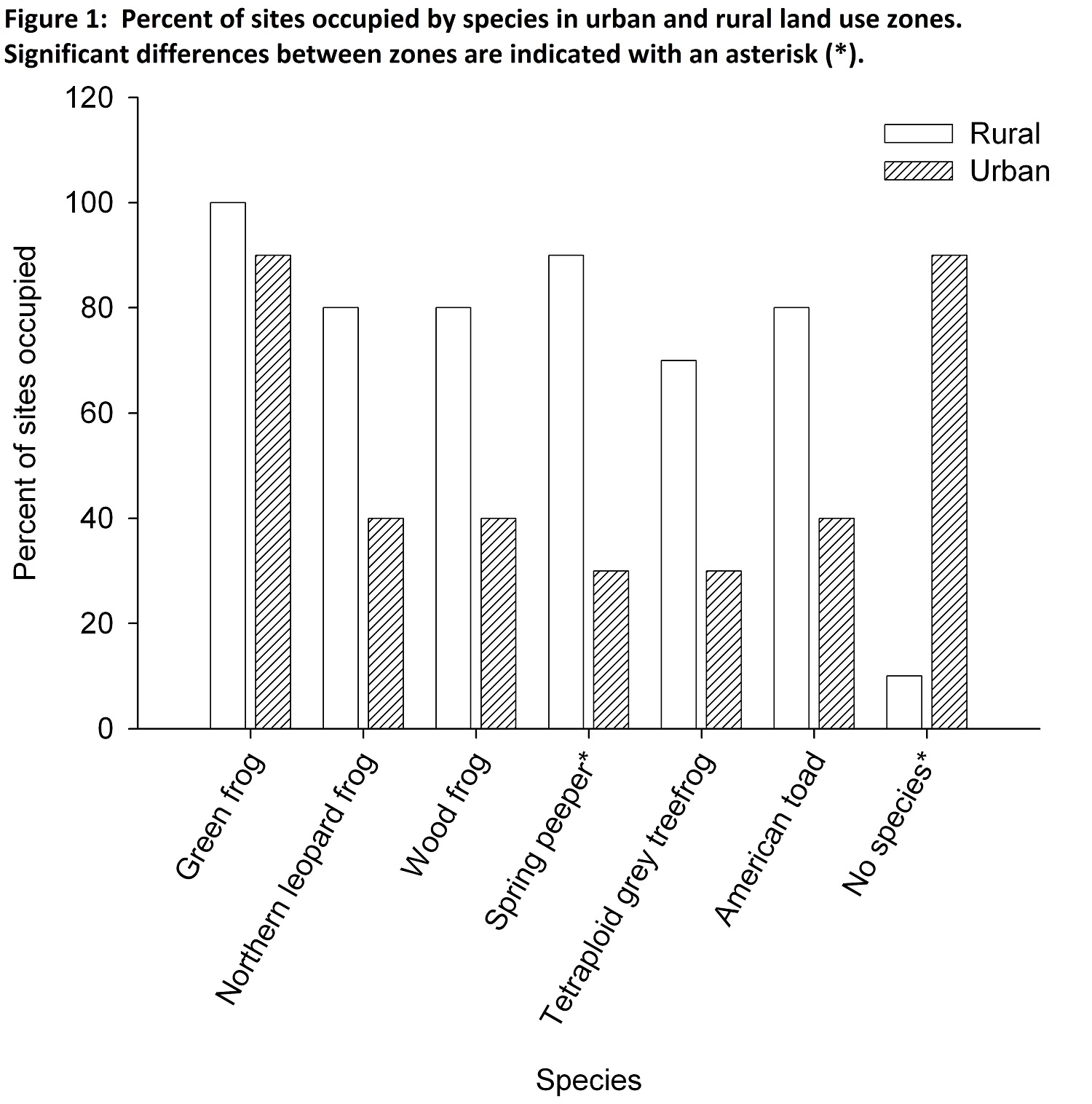The green frog (Lithobates clamitans) is still well distributed throughout many of the remaining regional wetlands. TRCA’s recently published report Terrestrial Long-Term Monitoring Report: Spatial and Temporal Trends 2008-2014 reveals that green frogs occupy 90% of urban wetland long-term monitoring sites and 100% of the rural ones.

This occurrence differs from the other regional frog species, which occur in most rural wetlands but tend to occupy fewer urban sites (Figure 1). For example, spring peepers (Pseudacris crucifer) occur in a significantly lower percentage of sites in the urban zone (30%) compared to the rural zone (90%).

Future academic research is needed to confirm what aspect(s) of urbanization are causing most regional frog species to occupy fewer urban wetlands. Paul Prior, TRCA’s fauna biologist, suggests the green frog’s high occupancy rate could be attributed to the species biology. Green frogs do not usually have to travel to adjacent habitats for feeding and overwintering like most amphibians, potentially making them less subject to mortality caused by vehicular traffic (Bouchard et al. 2009).
Frogs have long been used as biological indicators of the health of our environment by scientists worldwide due to their known sensitivity to the negative effects of urbanization such as increased road density, impaired water quality and loss of habitat (Knutson et al. 1999). Noise from urban areas can also interfere with frog communication and thus affect breeding success and survival (Lengagne 2008). Due to increased urbanization in the region, TRCA’s environmental monitoring team has surveyed for the presence of local frog species at long-term wetland monitoring sites since 2009 (Figure 2).

Using the Marsh Monitoring Program Protocol, TRCA biologists visit each site during the peak breeding season for each species to listen for the distinct mating calls of individual frogs. TRCA’s Terrestrial Long-term Monitoring Program also surveys vegetation and bird communities at wetland sites as well as other fixed sites that have been set-up in regional meadows and forests. The goal is to continue to monitor these sites well into the future to be able to proactively identify any negative trends in populations of local fauna and flora.
Despite the green frog’s resilience, TRCA’s long-term spatial data on frog communities is showing that the total number of frog species and the number of Regional Frog Species of Conservation Concern were significantly lower in urban wetlands (Figure 3).

The findings from the Terrestrial Biodiversity in the Toronto Region 2003-2012 report from TRCA’s Terrestrial Volunteer Monitoring Program (TVMP) further illustrate this strong relationship between decreased biodiversity and increased urbanization. This report highlights the importance of minimizing habitat loss, but also the negative influences that urban areas exert on remaining natural areas.
For example, TVMP sites with the greatest proportion of natural cover within 500 metres tended to have greater biodiversity and support more Regional Species of Conservation Concern. Biodiversity was further enhanced at TVMP sites containing a higher area of wetlands within 2 km. This data suggests frog species benefit from a variety of natural habitat types in close proximity including upland forests, wet forests and emergent wetlands.
While TRCA’s current monitoring data (2009-2014) are showing that frog populations are stable over time, it is important to highlight past losses in wetlands throughout southern Ontario which have likely impacted frog populations. Between the early 1800s and 2002, southern Ontario has seen a 72% loss in wetland habitat due to urbanization, with losses in the Toronto area estimated to be higher at 85% (Ducks Unlimited Canada 2010). Continued long-term monitoring by TRCA should track if future declines in frog populations occur at the regional or wetland scales.
Did you know? TRCA’s environmental monitoring team is currently involved in two baseline road ecology studies, within the Oak Ridges Moraine Corridor Park and at stream crossings in the Humber and Rouge watersheds.
Monitoring Matters! Through scientific data collection, TRCA’s Environmental Monitoring and Data Management team tell the stories about the changes affecting the natural areas and watercourses within our regions. For more information, please visit our website, follow us on Twitter, subscribe to our Monitoring Matters e-newsletter, or visit our YouTube playlist.
| Regional Frog Species
Eight frog species were detected in regional plots across TRCA’s jurisdiction between 2009 and 2014 including (in descending order of abundance measured as the percent of sites occupied):
|

